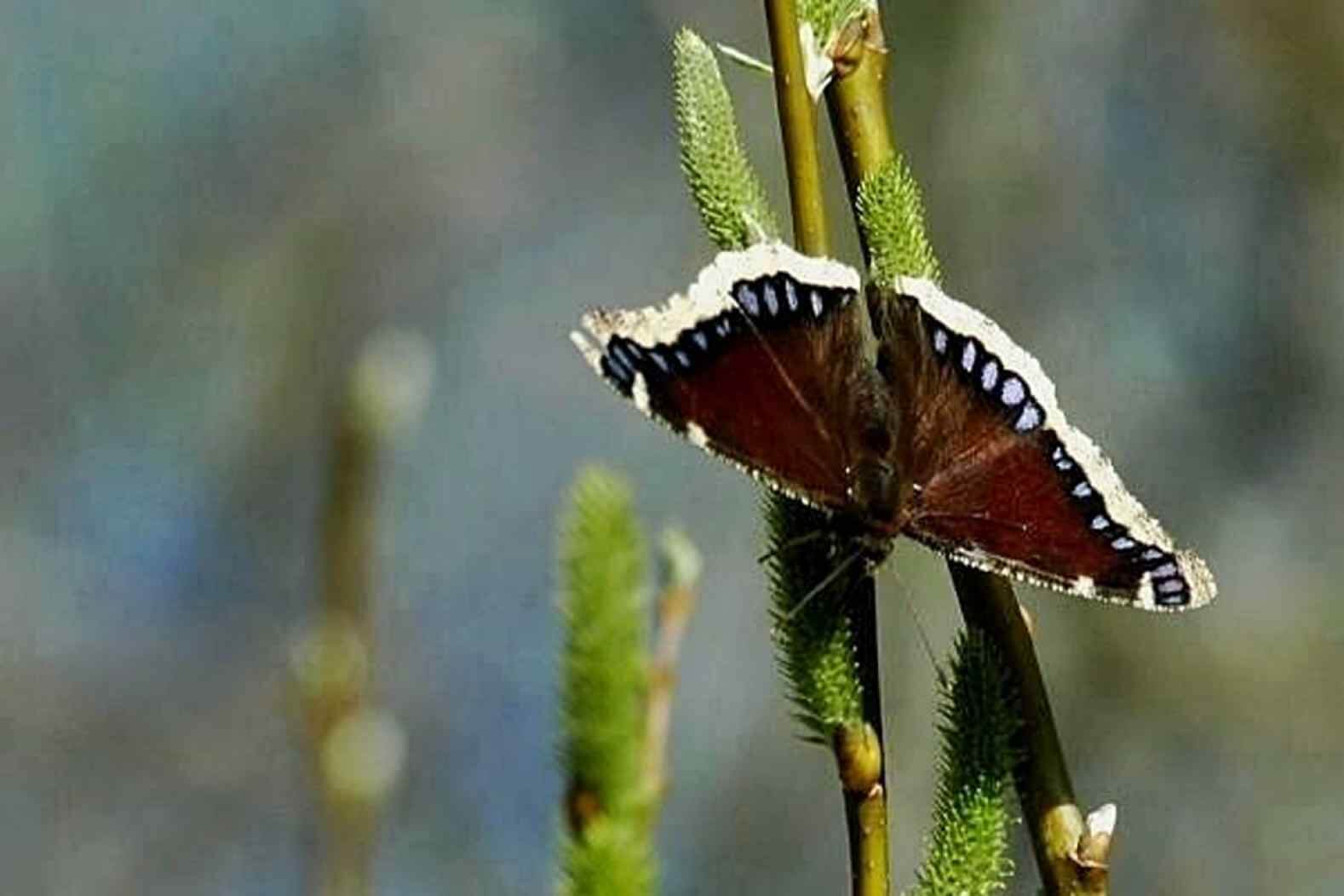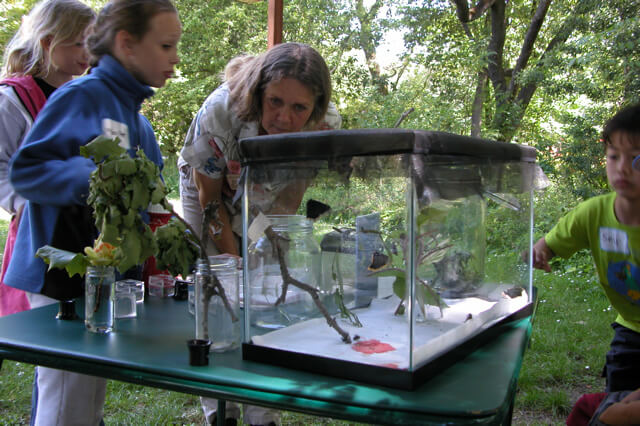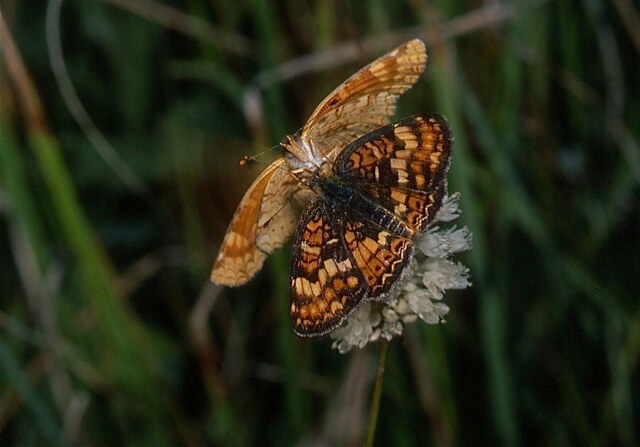The Mourning Cloak (Nymphalis antiopa) is fairly common in Marin, and adults can be seen flying almost any time during the year. This species is also found in Europe; on the British Isles it is known as the Camberwell Beauty, and considered the rarest of British butterflies. In Marin we see this butterfly throughout the year; in more inland areas the adults migrate to higher altitudes in summer, and disperse again downslope in the fall.
Unlike most butterflies the Mourning Cloak lives nearly a whole year in the adult form. On cold or wet days in fall and winter, it will find shelter amongst leaf litter or in crevices of tree trunks or fallen logs. I have watched a butterfly fly to a resting spot like this, and once it has settled in, with wings folded, it is perfectly camouflaged. On clear sunny days, even early in January, it will be one of the few butterflies on the wing.
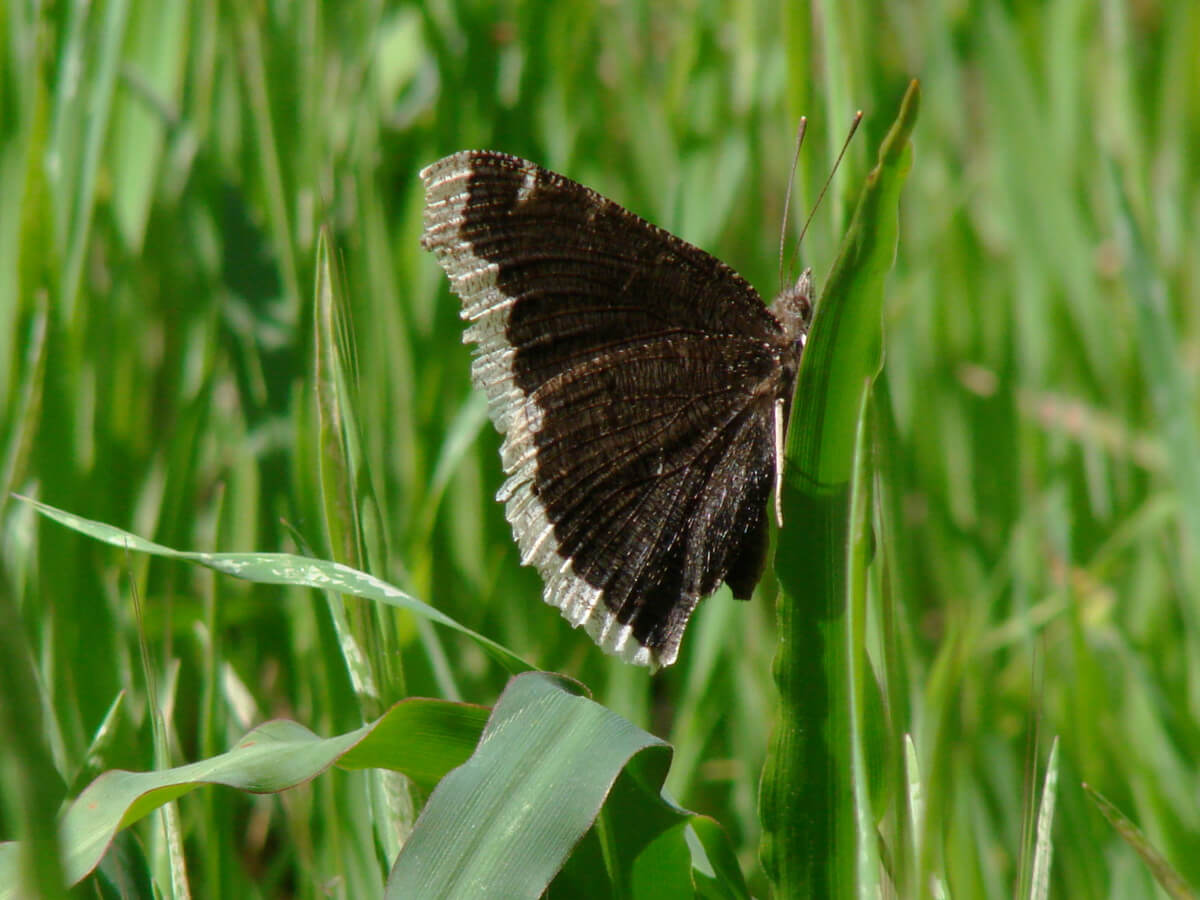
The underwing of the Mourning Cloak blends perfectly with bark or leaf litter.
The Mourning Cloak is a butterfly of wooded areas and riparian habitats, though it is not unusual to see it in really urban areas. That’s because some of the trees commonly planted in urban parks and landscapes are the host plants for the larvae of the Mourning Cloak. The primary larval host is Willow; but larvae also feed on non-native Salix species like the Weeping Willow. Eggs are also laid on native and non-native Poplars and Elms; and on native Alders.
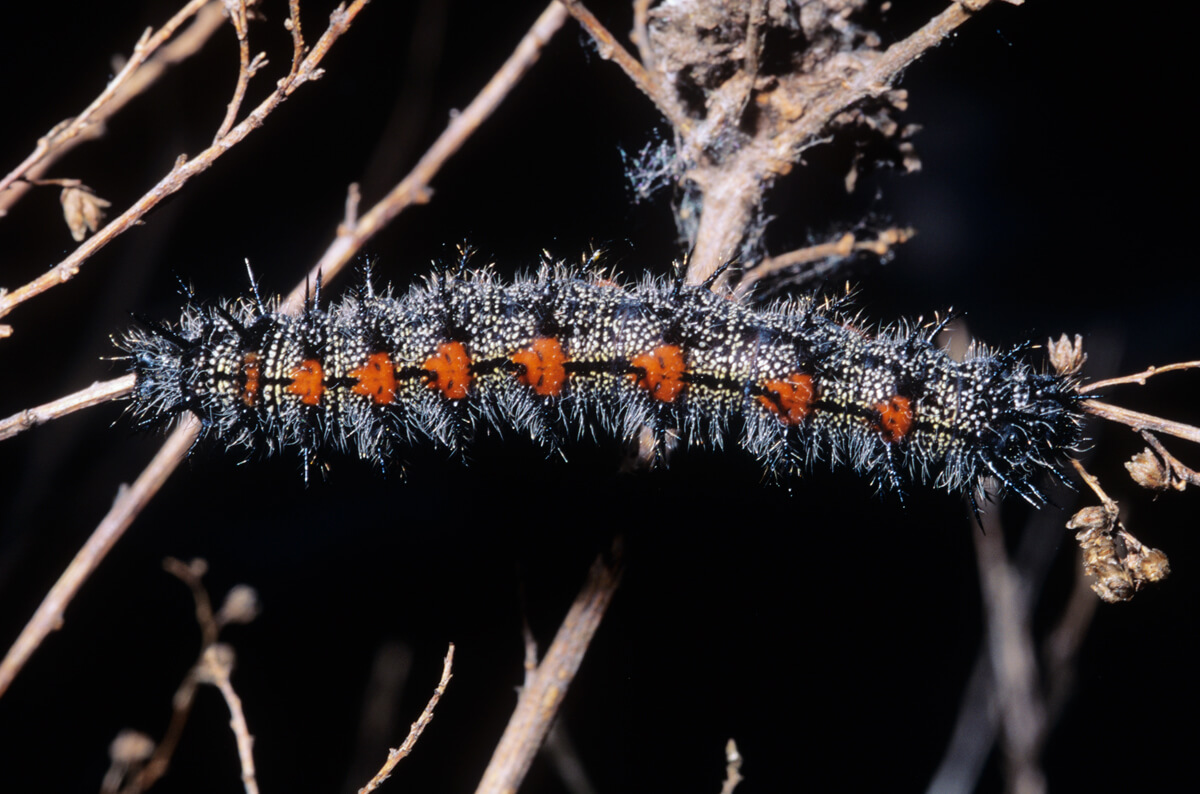
Mourning Cloak caterpillar
The eggs are laid in large batches; and the larvae are gregarious during their development. The larvae are spiny, but the spines are not urticating; that is they will not cause a stinging or burning reaction in contact with human skin. In some lepidopteran species the larvae are covered with spiny hairs that sting and break off when they are handled. This is another defense for the larva; those tiny hairs are similar to the spiny defense of a cactus plant.
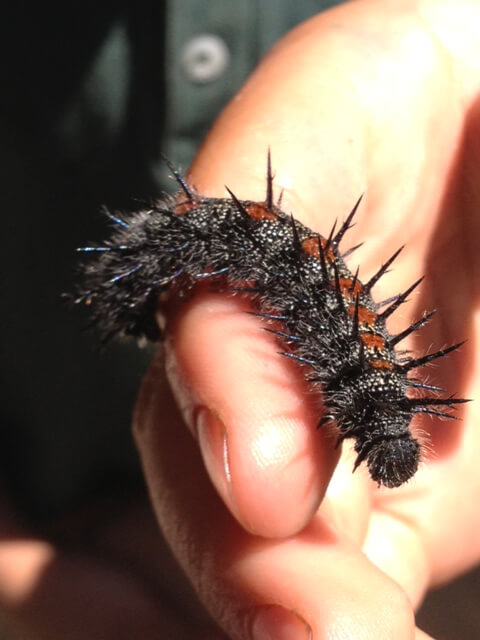
In this photo you can clearly see the six true legs that caterpillars use to handle their food; larvae are also equipped with ‘prolegs’ which give them a good hold on plants.
In any case, it is not a good idea to handle lepidopteran larvae too much; because all along the sides of their bodies are tiny ‘vents’ called ‘spiracles’ which the larvae breathe through. These spiracles can get clogged by the oils that are on human skin. Children do love to hold these tiny creatures, and it’s good to look at them really closely; but a much better way to get them close, and move them if necessary, is to keep the larva on the plant material, and hold onto that!
I have raised this species on both willow and elm; its fun to watch the larvae; they all move at the same time, sometimes in a long trail with larvae head to tail! If one individual starts to wiggle, then they all wiggle about furiously. These types of behaviors probably help to create an image of a much larger organism, and thereby offer the species some protection from predators.
In captivity all the larvae pupate, and eclose from the pupa at about the same time. The pupa hangs head down from the silken button, and is grayish with tiny black dots sprinkled all over it. When each adult emerges from the pupa it releases meconium, which is the waste product of metamorphosis. The meconium is red, and a rather large drop is released upon emerging from the chrysalis. It’s not hard to imagine, if there was a large congregation of butterflies, all eclosing at the same time, that it might look like ‘blood raining from the skys’. During medieval times in Europe this ‘red rain’ was taken as a religious omen.
I raise caterpillars in a re-purposed fish tank; the paper towels are changed regularly to keep living conditions sanitary. You can clearly see the red spots of meconium on the white paper.
I had a lot of fun with a class of third-graders one year when the timing was perfect, and each student was able to briefly hold a butterfly before sending all the Mourning Cloaks off on their maiden flights!
Buckeye – Junonia coenia
This beautifully colored butterfly is most common in our area in the late summer and fall. The Buckeye prefers the open spaces, whether in urban areas or the wild; it avoids closed-canopy forests. It can often be seen on dirt roads and pathways, wings spread, sunning itself. The eyespots presumably distract predators. Visual predators like birds will peck at the wings, pieces of which can be sacrificed to protect the body of the insect.
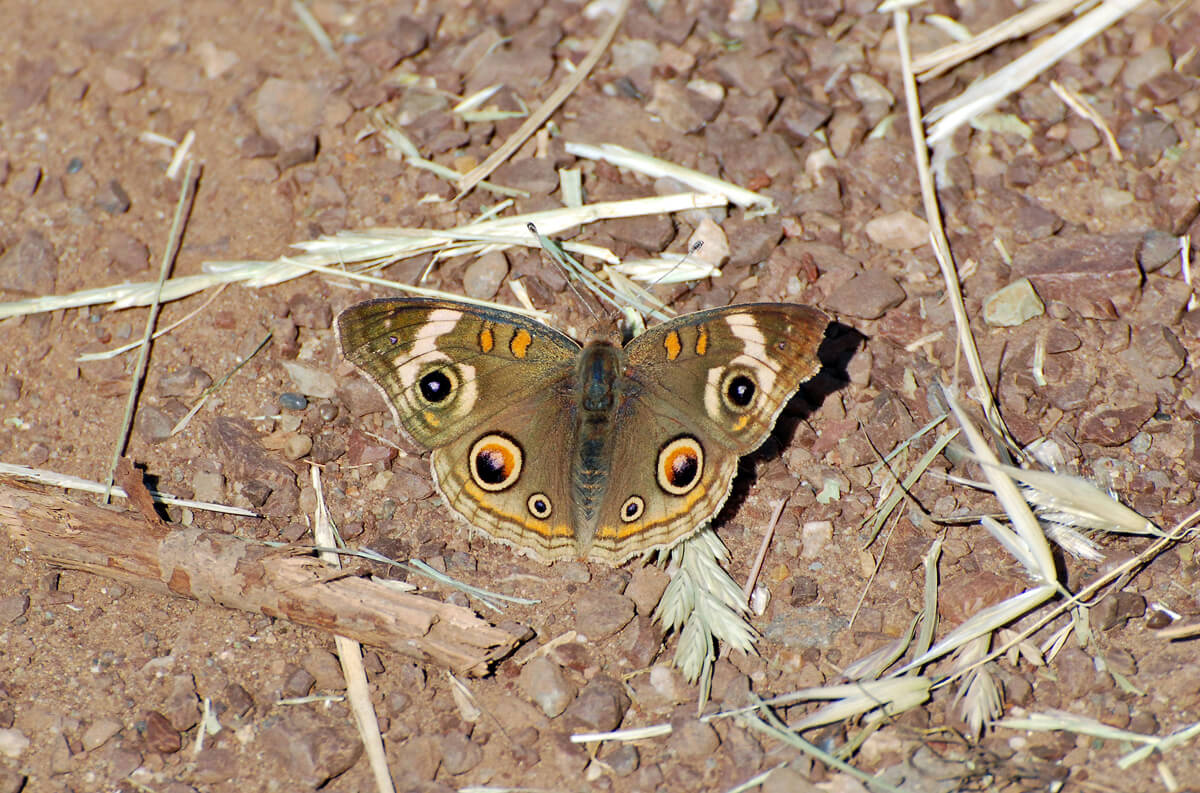
A Buckeye butterfly basking in the sun
The larva are dark and spiky with an orangey head; they feed in the open on plants in the Scrophularia, or Figwort,family. Many plants in this family are common and easy garden plants, such as Snapdragons, Penstemon and Diascia. I’ve seen larvae feeding on Toadflax (Linaria purpurea), which is a wildish sort of plant in my garden. It is a Scrophularia family member from the Mediterranean; and the sort of plant that is best when allowed to grow where it seeds itself in. Linaria is also an excellent bee forage plant.
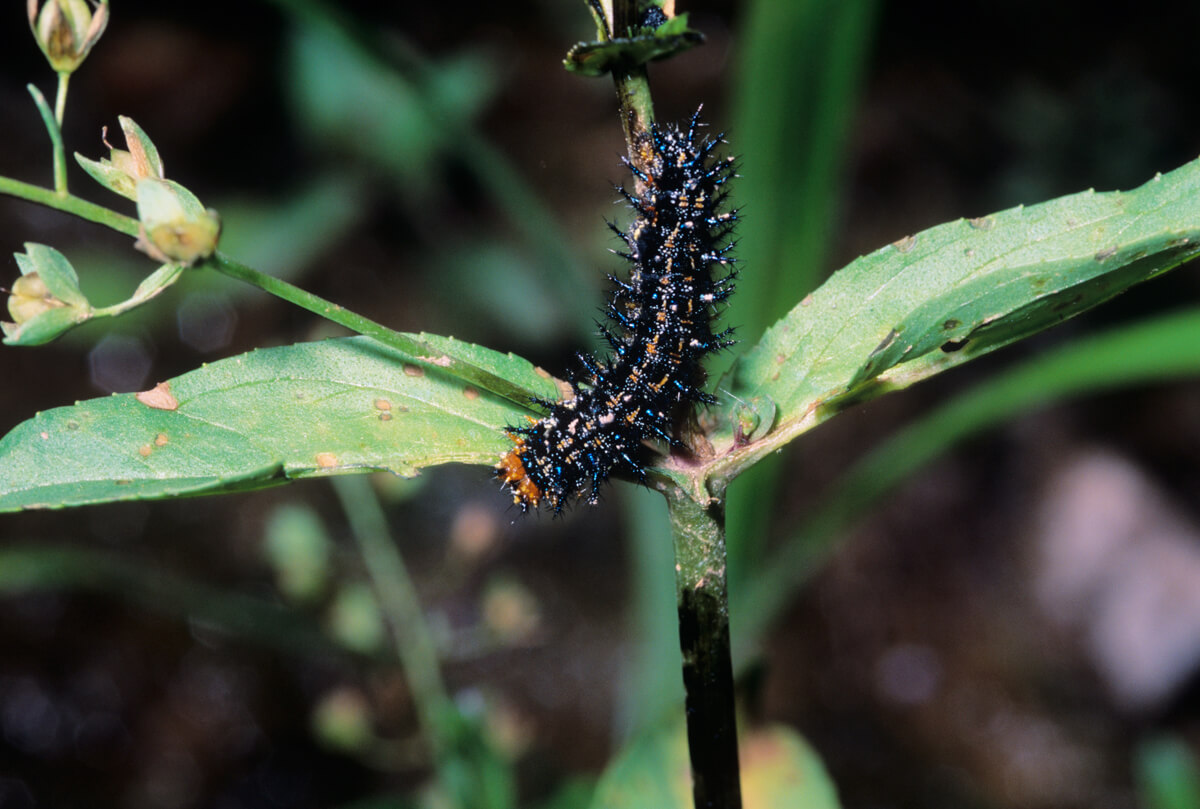
Buckeye larva
Plants from other families are sometimes used as larval hosts; English Plantain (Plantago lancelota), Fogfruit (Lippia or Phylla nodiflora), and Mare’s Tail (Hippuris vulgaris). Though from different families, these plants, like the Scrophulariaceae, contain iridoid glycosides, a group of very bitter compounds that may offer some protection to the larvae. Plants within certain families often create secondary bio-chemicals not essential to the life of the plant; but essentially to attract and provide for insects.
California native plants in the figwort family that are used as host plants are some of the Monkeyflowers, and sometimes the California bee plant (Scrophularia californica). I grow several species of Monkeyflowers; there are distinct differences between what I like to call the ‘dry monkies’ and the ‘wet monkies’.
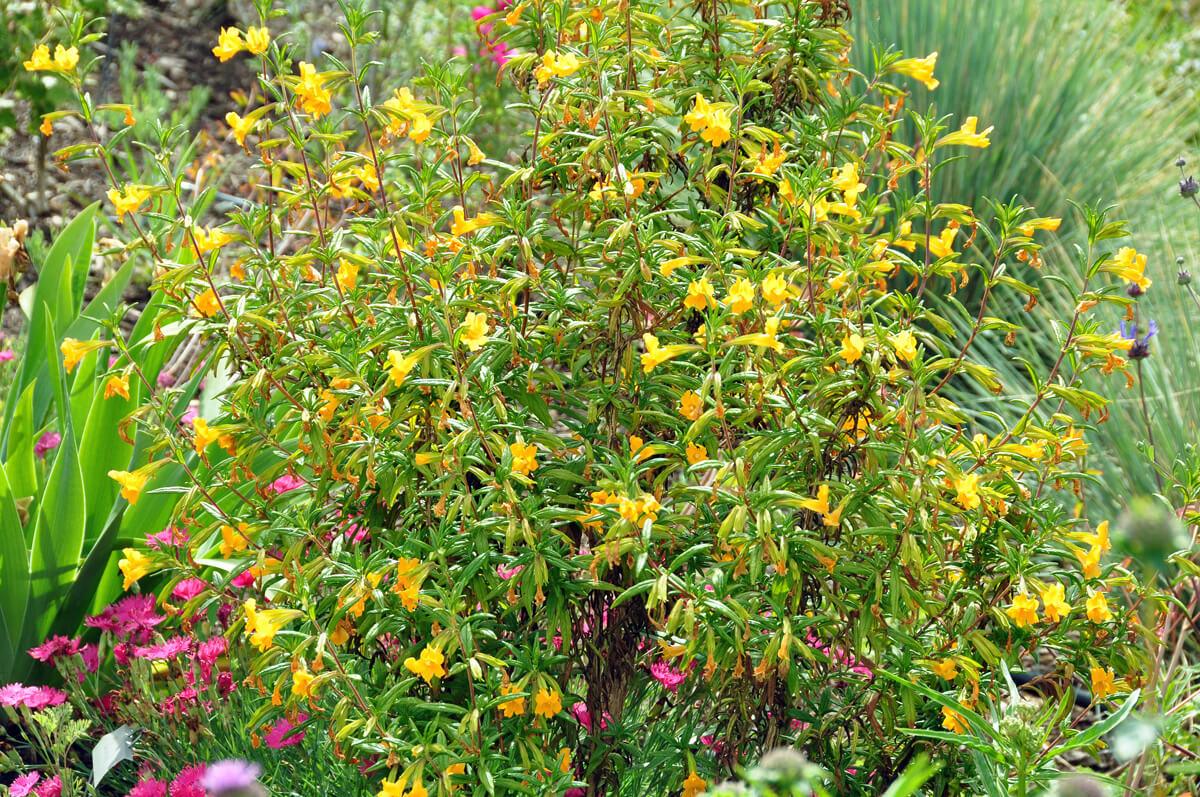
Sticky Monkeyflower in a mixed border planting
Sticky Monkeyflower (Mimulus or Diplacus aurantiacus) is a semi evergreen shrub of dry places. Fresh new leaves appear in early spring, and by March or April I sometimes see the larvae feeding on this shrub. By early summer the leaves have become really sticky as protective oils build up in them; and at that point nothing really feeds on the leaves.
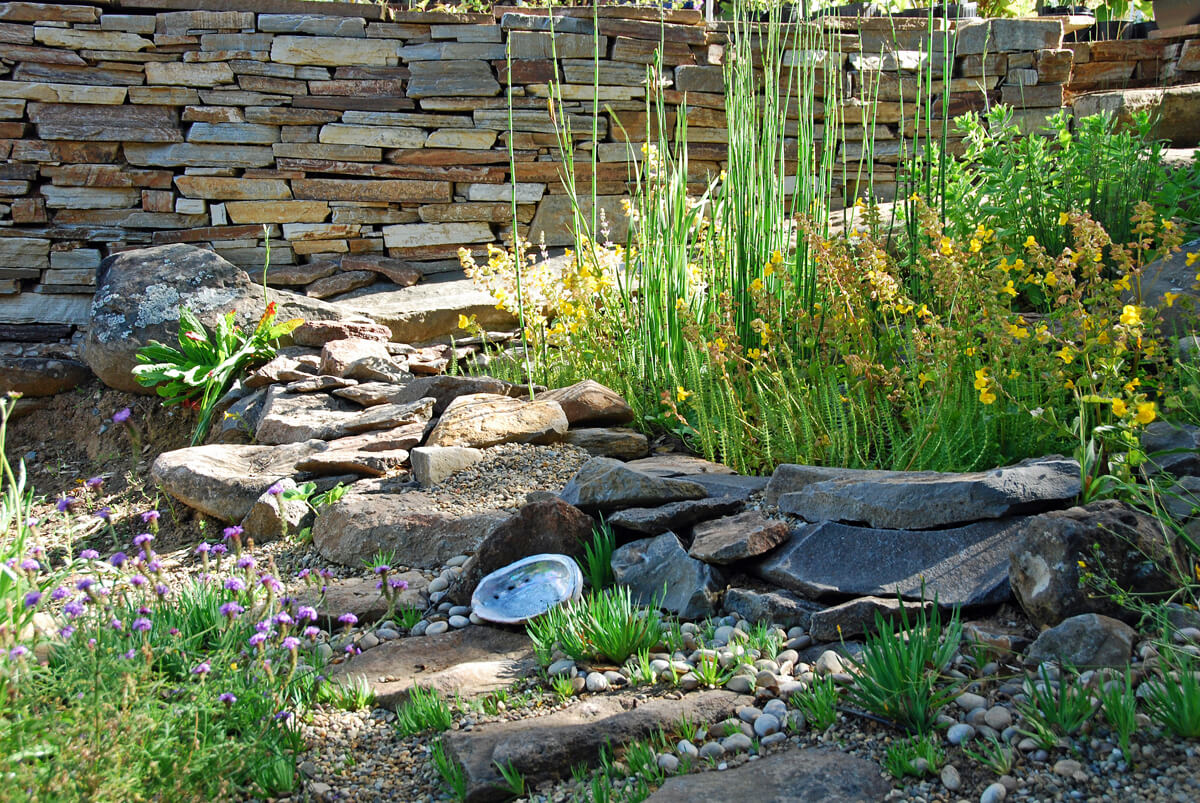
Within this little bog and frog pond are lots of resources for wild creatures; including Seep Spring Monkeyflower, and Mare’s Tail which sometimes host the larvae of the Buckeye butterfly.
Cardinal Monkeyflower (Mimulus cardinalis) and Seep Spring Monkeyflower (Mimulus guttatus) are herbaceous perennials of bogs and other wet places. The leaves are soft and new growth occurs later in the season; much more in tune with the life cycle of the Buckeye. Mare’s Tail (Hippuris vulgaris)also grows in boggy areas, and that’s a plant that I have personally seen Buckeye larvae feeding on.
I keep a controlled patch of Plantain growing in my garden. The English Plantain (Plantago lanceolata), called ‘white man’s footsteps’ by the native peoples, is an introduced plant that now grows all over North America, and is both a great habitat plant, and a plant with medicinal properties.
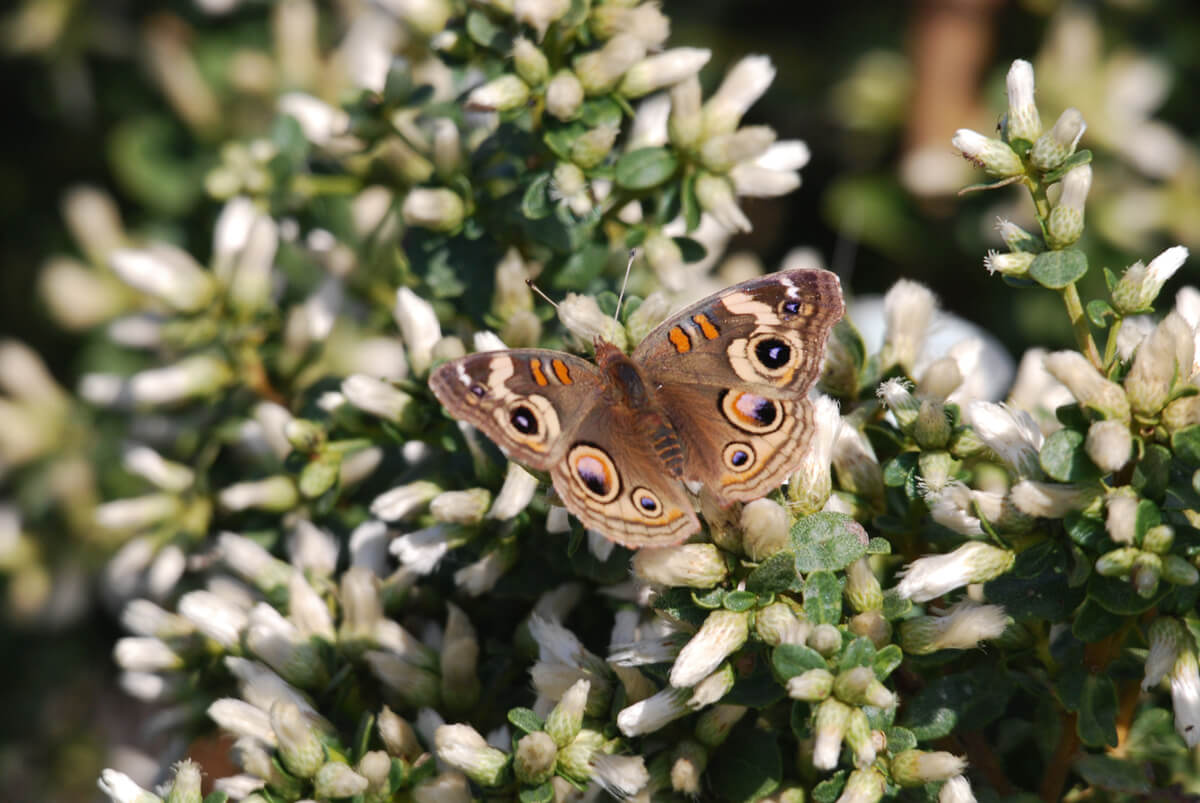
Buckeye butterfly coming to the flowers on Coyote Bush
By late summer and right through fall, if the weather is dry, I see Buckeyes swarming at the flowers of Coyote Bush (Baccharis pilularis) and Shrubby Buckwheat ( Eriogonum fasciculatum). Both are great habitat plants, and deer-proof once established.
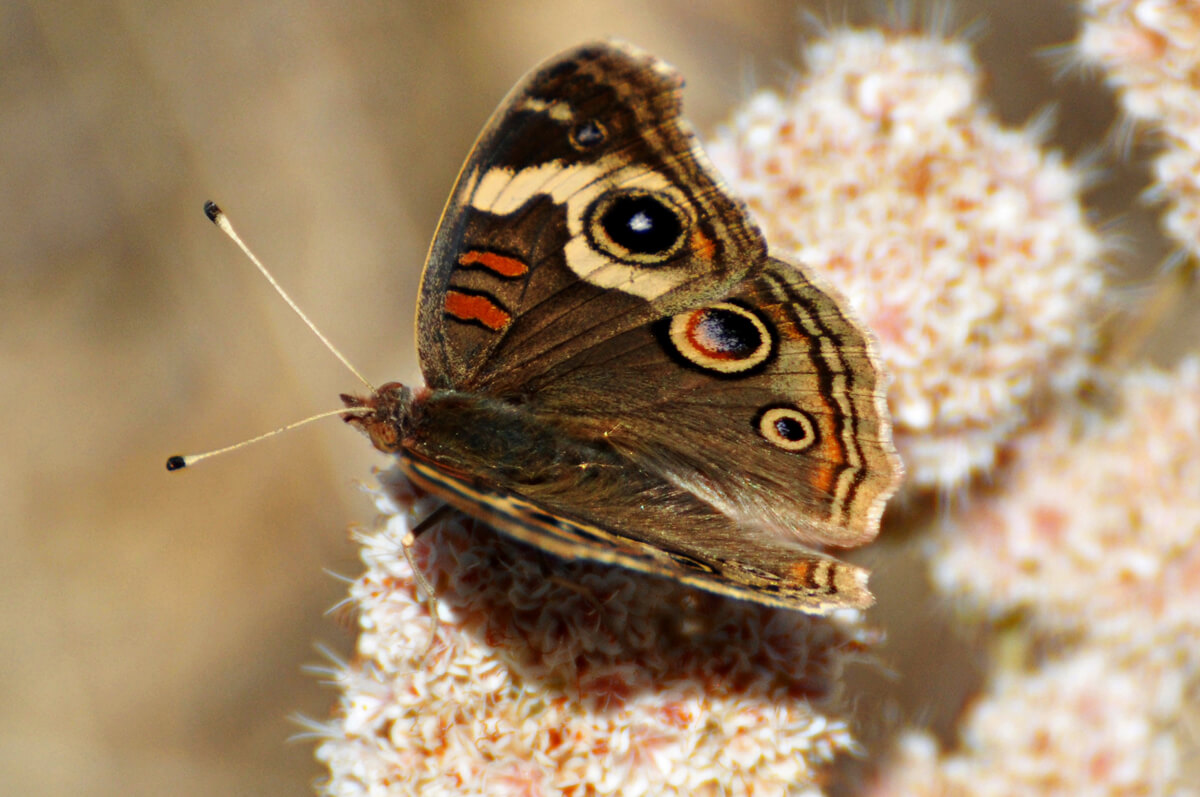
Buckeye butterfly nectaring on Shrubby Buckwheat
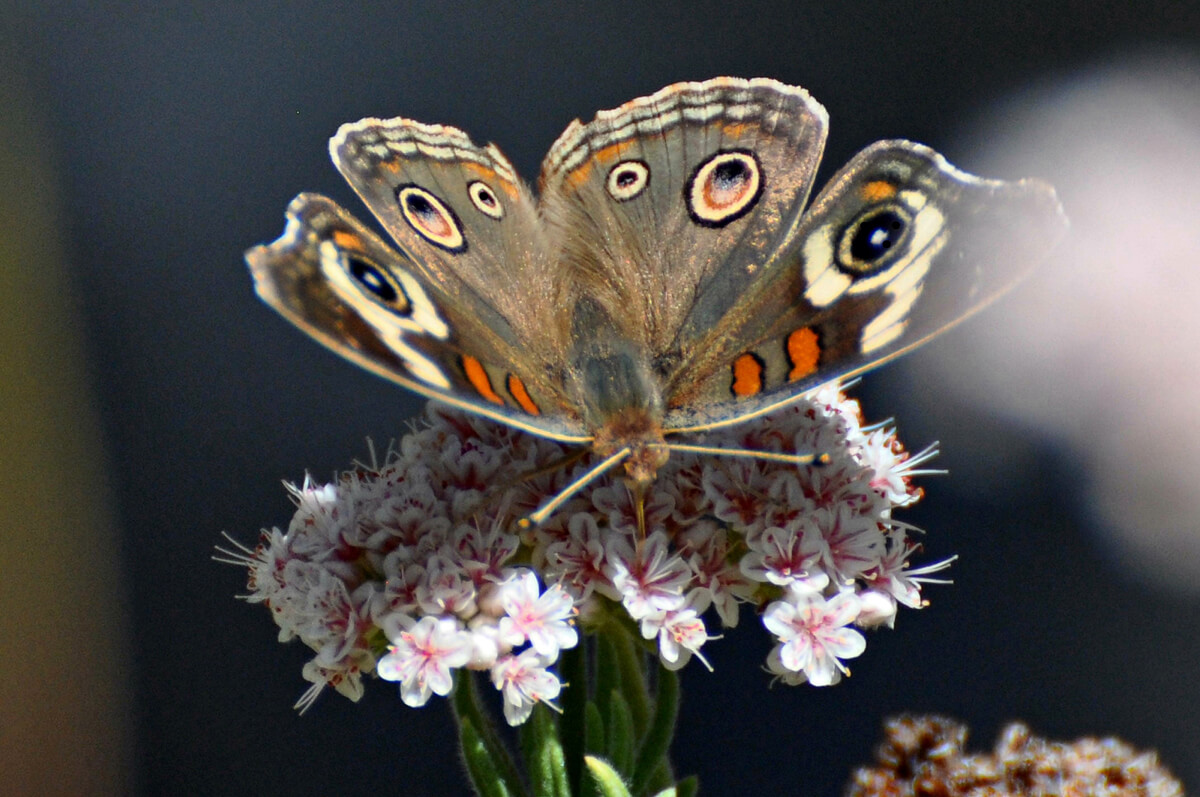
In this photo it is easy to understand the appeal of Buckwheat flowers.
In this photo it is easy to understand the appeal of Buckwheat flowers; each flower ‘head’ contains numerous small flowers, each one with a supply of nectar. You can also clearly see the proboscis dipping into a single little flower within the ‘head’. The insect saves a lot of energy when it can stay in one place for a while and dip into a large number of flowers.
Variable Checkerspot – Euphydryas chalcedona
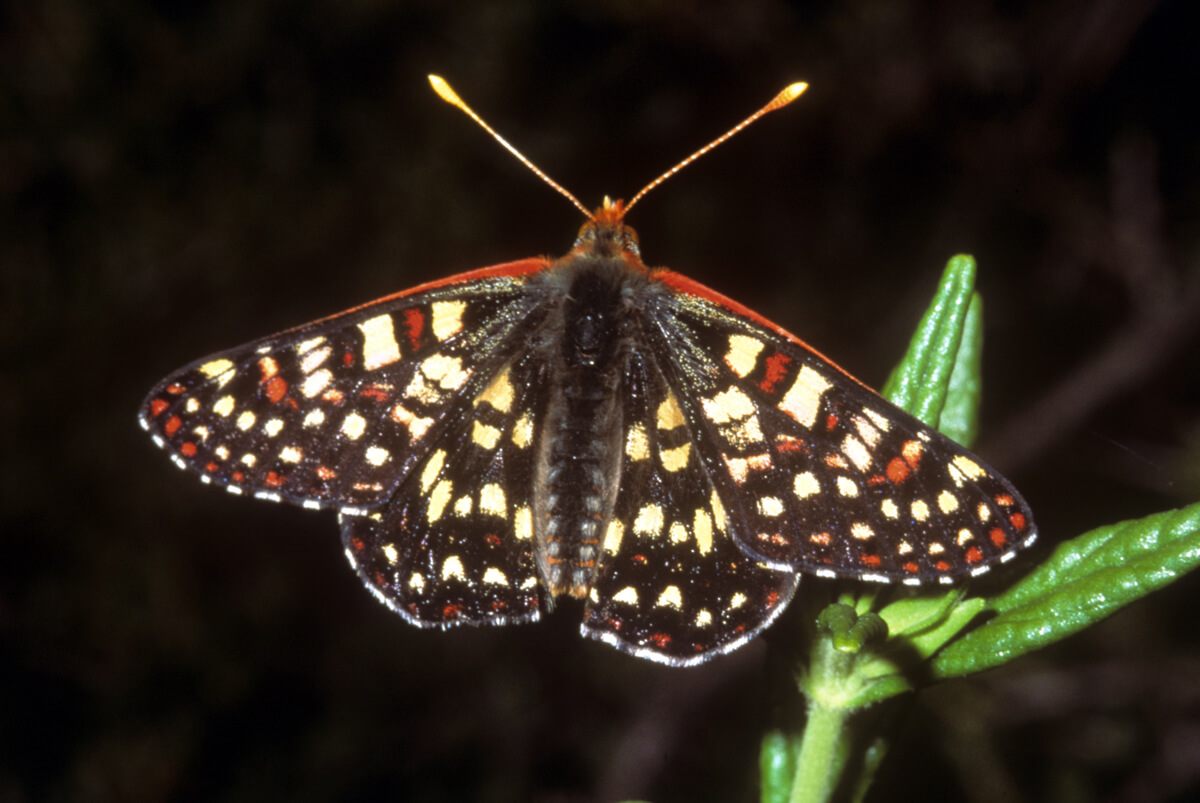
Variable Checkerspot butterfly (photo by Bob Stewart)
This is another butterfly with close associations to native plants in the Snapdragon family (Scrophularicaeae), but one that rarely ever lays eggs on any of the common garden non-native ‘Scrophs’; unlike the Buckeye butterfly. Perhaps it’s because Variable Checkerspots are a rare sight in gardens, unless that garden happens to be close to open space with just the right sort of canyons, and at the right elevation.

Variable Checkerspots mating (photo by Nancy Hanson)
Both the Buckeye and the Variable Checkerspot breed on plants containing iridiod glycosides, and make use of these bitter compounds for their own defense. The Variable Checkerspot is warningly colored in red, black and white. I think one of its most beautiful features are the red antennae and red legs. The checkered pattern varies somewhat in individuals, but there’s always a dash of red right at the leading edge of the forewing. The females are usually bigger, and adults fly for just a few months, usually March or April through July.

Early instar Variable Checkerspot larvae feeding on Monkeyflower close to their web (photo by Nancy Hanson)
Early in their development larvae are gregarious and build a web for protection. Eggs are laid in a mass, so the female chooses plants that are large enough to sustain all the larvae from that egg mass. Sticky Monkeyflower is the most common host plant, sometimes eggs are also laid on the California Bee Plant. Eggs are usually laid in early spring, and the larvae feed on the Monkeyflower until the leaves get too sticky, usually early summer. Then they go into a diapause, curled up somewhere in the leaf litter, waiting until the next spring.
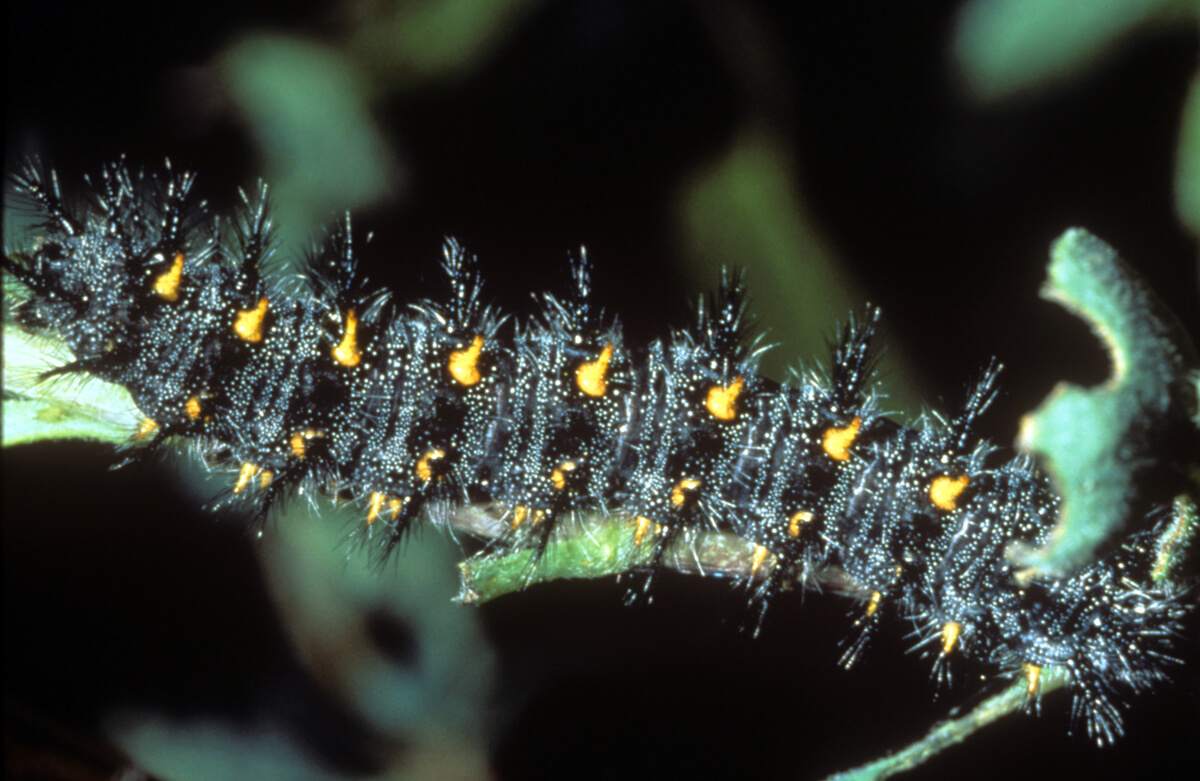
Later instar larva look similar to the Buckeye larvae, but without an orangey head. (photo by Bob Stewart)
The larvae that emerge from diapause in spring feed on smaller plants in the same family, natives such as Chinese Houses (Collinsia heterophylla), Indian Warrior (Pedicularis densiflora) , and Indian Paintbrush (Castilleja spp.); and the non-native English Plantain (Plantago lanceolata). They’re no longer gregarious, and they will complete the life cycle in the second year.

This Variable Checkerspot larva is feeding on an Indian Paintbrush flower.
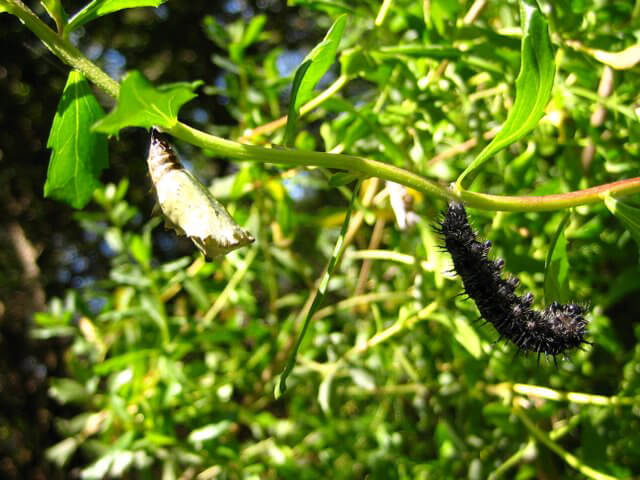
In this photo you can see both the ‘pre-pupal’ stage, and a pupa of the Variable Checkerspot. (photo by Nancy Hanson)
Most of the photos illustrating this section were taken by Nancy Hanson in her garden; which happens to be situated favorably for the Checkerspots. Nancy maintains a beautiful organic garden, with a wonderful mix of natives and ornamentals, so naturally, it’s full of life!
One of my first and most memorable experiences with butterflies; the one that really got me started on habitat gardening about eighteen years ago; was to come across Monkeyflower shrubs full of larvae in the oak woodlands behind our house; and then to see swarms of Variable Checkerspots on flowering shrubs right by our house. That was a meaningful three way connection for me; host plants and nectar plants; and living close to the wild and wonderful open spaces of Marin!
Mylitta Crescent – Phyciodes mylitta
and Field Crescent –Phyciodes campestris
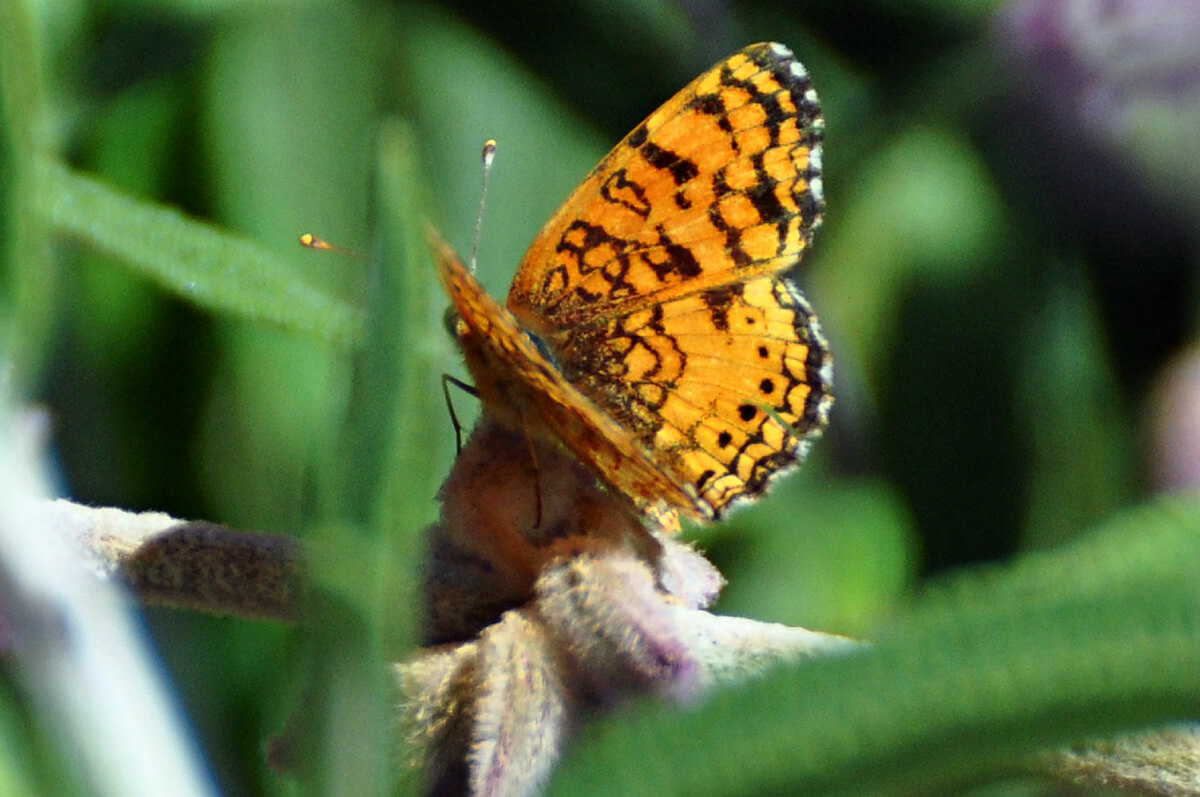
The Mylitta Crescent butterfly
Field Crescent butterflies (photo by Bob Stewart)These are small butterflies, named for the crescent shaped markings along the hind wing margins. The checkered patterns that adorn the wings are in shades of orange, yellow-orange, black, brown and white. The Mylitta Crescent is overall a lighter colored butterfly, the Field Crescent a much darker butterfly. In my experience the Mylitta flies earlier in the year, the Field later in summer. Both butterflies visit a lot of flowers for nectar, so they’re a common sight in gardens.
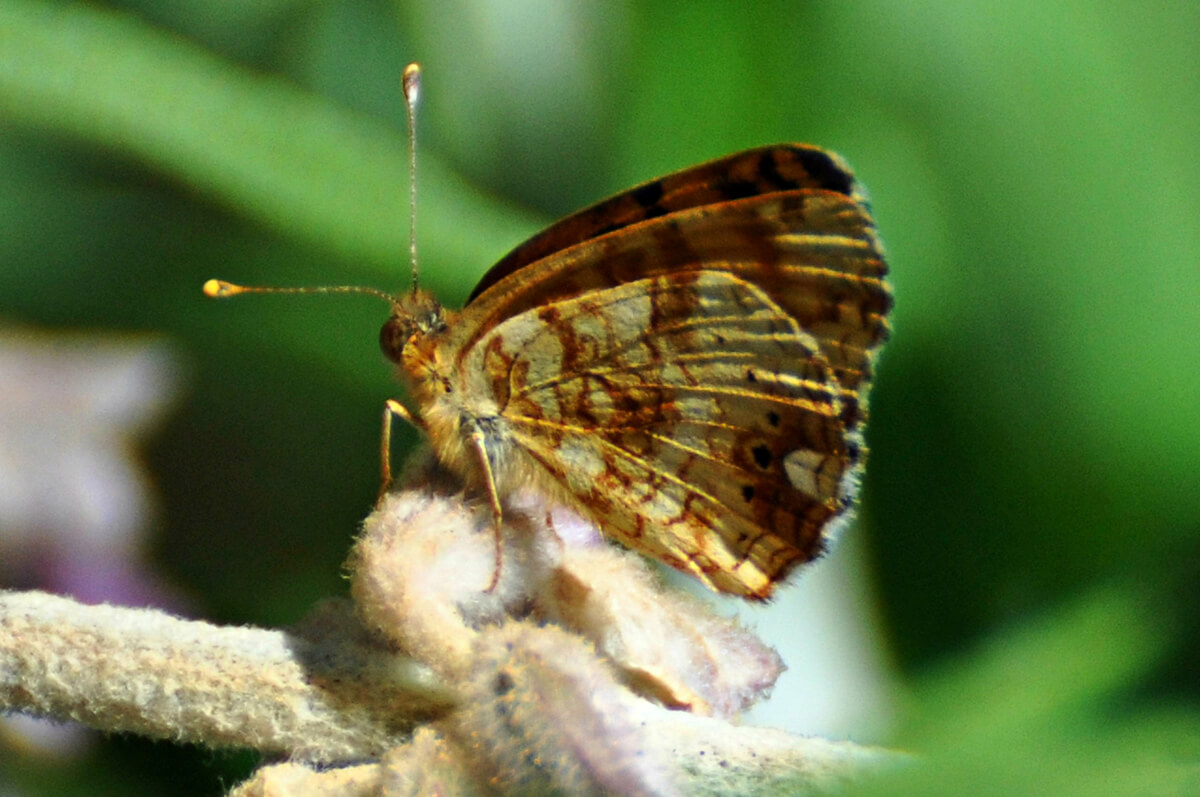
The underwing of the Mylitta Crescent
Both these Crescents use plants in the Composite family as hosts for their larvae. The Mylitta Crescent lays its eggs on thistles; any of the major groups of introduced weedy ones, such as Cirsium spp., Carduus spp., or Silybum spp. The Field Crescent lays its eggs on the native California aster (Aster chilensis).
I keep controlled patches of Italian Thistle (Carduus pycnocephalus) growing on my property, and every spring I find a host of creatures on these plants. This is where I see the first Soldier Beetles, lots of ladybird beetles and their larvae hunting aphids, lots of spiders, and usually caterpillars; both large and small. The large caterpillars are Painted Ladies, the small ones are Mylitta Crescents. I learn these things by observation; bringing in a few individuals to raise them along, and finding out what they are as I watch the whole fascinating process of metamorphosis.
I also grow the native Cobweb Thistle (Cirsium occidentale) in my garden; this plant supports a lot of life and unlike the European thistles, it is not invasive. It grows wild closer to the coast, but also in places on Mt. Tamalpais; but is somewhat difficult in garden culture, and harder still in nursery pots. Once established in the garden, it’s another one of those plants that has to decide for itself where it wants to grow! And I do my best to accommodate it!
These are both lovely little butterflies, and it is a delight to see them in the garden.


